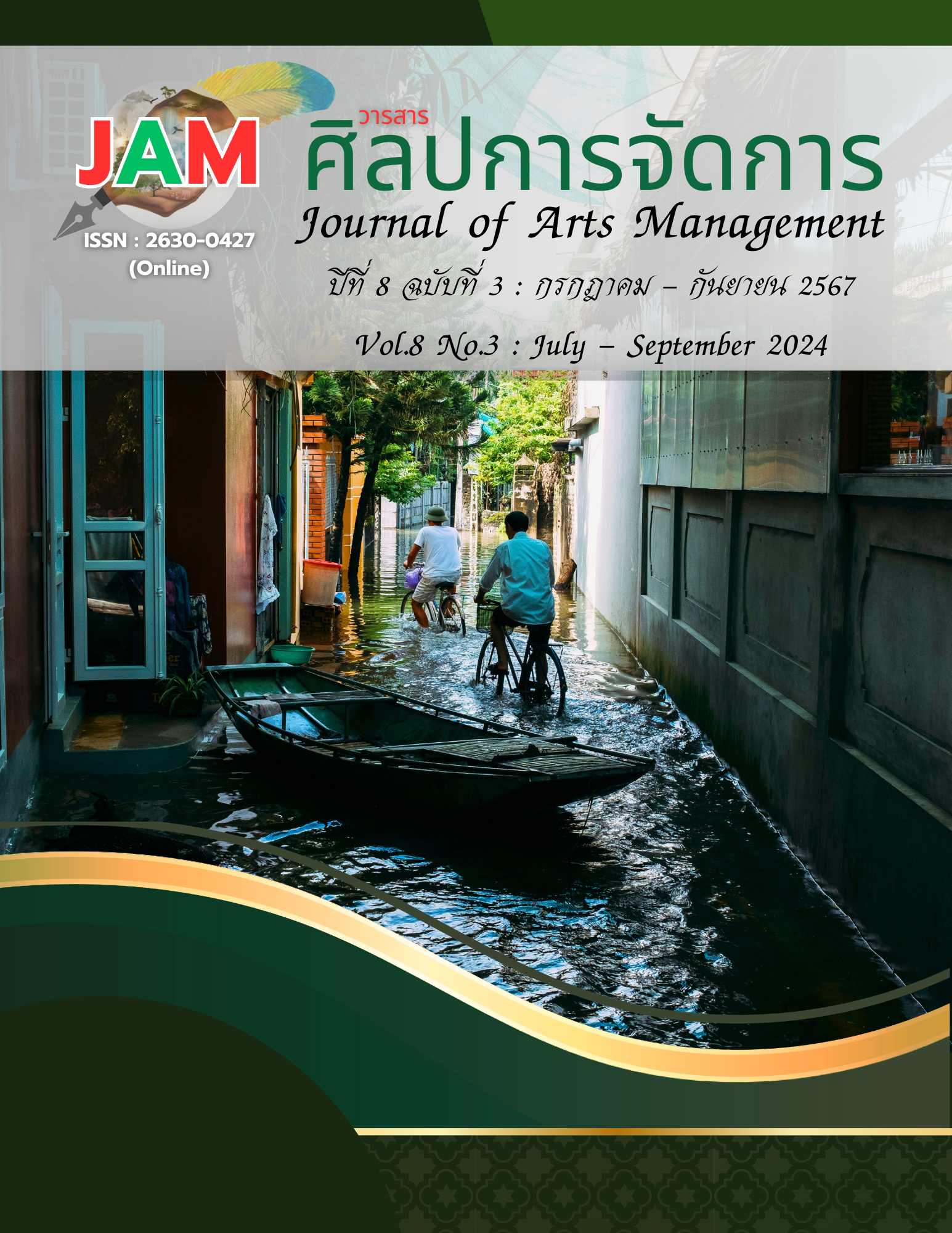Development of Riverside Lifestyle Tourism Potential, Nong Suang Village, Krachaeng Subdistrict, Bang Sai District, Phra Nakhon Si Ayutthaya Province
Main Article Content
Abstract
The purposes of this article are to 1) study the potential of riverside lifestyle tourism, 2) create development strategies for riverside lifestyle tourism, and 3) design a Business Model Canvas for developing riverside lifestyle tourism in Nong Suang village, Bang Sai district, Phra Nakhon Si Ayutthaya province. In addition, qualitative research was employed in this research. Data collection instruments included SWOT analysis, TOWS matrix, and Business Model Canvas (BMC). Descriptive statistics were used to analyze the data. The research results were found as follows;
1. Riverside lifestyle tourism potential strengths include S1 attractive features like natural water sources and S2 well-developed facilities including accommodations S3 easy access with multiple travel routes to the community, and S4 competitive tourism costs. The weaknesses included W1 lack of knowledge in developing tourism activities, W2 limited public relations and media presence, W3 travel routes currently under repair, W4 inadequate bathroom facilities, W5 limited tourists’ access during the rainy season, W6 absence of established tourism standards, and W7 lack of financial resource. In addition, the opportunities included O1 capitalizing on the popularity of cultural tourism, O2 government support, and O3 research funding. Furthermore, the threats included T1 water disaster, T2 water hyacinth, T3 economic downturn, and T4 tourism competition.
2. Development strategies consisted of one SO strategy, three WO strategies, one ST strategy, and one WT strategy.
3. The business model of riverside lifestyle tourism potential development included three aspects: 1) the marketing aspect, focusing on target customers and creating awareness and creating value in products and services for the target group; 2) the operational processes aspect; and 3) the financial aspect, displaying income and expenses required for operations.
Article Details

This work is licensed under a Creative Commons Attribution-NonCommercial-NoDerivatives 4.0 International License.
Views and opinions appearing in articles in the Journal of Arts of Management It is the responsibility of the author of the article. and does not constitute the view and responsibility of the editorial team I agree that the article is copyright of the Arts and Management Journal.
References
Bunnamsirikit, P., & Suthipisan, S. (2021). Unit 15 Cultral tourism towards sustainable tourism. Teaching materials for the culture subject set. Liberal Arts major Sukhothai Thammathirat Open University.
Chakthong, C., & Kaewnuch, K. (2022). Factors Affecting Active Agine Tourist’s Decision to Join Agrotourism Activity in Thailand. Journal of International and Thai Tourism, 18(1), 62-85.
Chantanee, M., & Inthason, S. (2023). Uprading the Potential of Creative Community – based Tourism to Develop the Area Based on the Local Identity of the Sri Ayutthaya Group Network in the Community Area of Khlong Chik. Journal of Arts Management, 6(3), 153-170.
Chouykaew, T., & Jirojkul, S. (2019). Pak Phanang’s River Cultural Route Development for Tourism Marketing Promotion, Pak Phanang District, Nakhon Si Thammarat Provice. Academic Services Journal Prince of Songkla University, 30(3), 80-97.
Dickman. S. (1966). Tourism: An Introductory Text. Hodder Education.
Jantawong, S. (2022). Guidelines for Community – Based Tourism Development in Area of Ban Tha Tian, Doem Bang Sub–district, Suphan Buri Province. The 19th KU KPS National Conference. Kasetsart University Kamphaeng Saen Campus. 8-9 December 2022.
Khamkerd, T., Rueangrit, U., Sangiemsilp, P., Therawat, J., & Markjan, C. (2020). Community – based Tourism Management Model on the Foundations of Sustainable Community Lifestyles of Tontan Subdistrict Songphinong District, Suphanburi Province. Raiamangala University of Technology Suvarnabhumi.
Leelakitpaisarn, Y., Chaovanapricha, K., Chuanchomb, J., Srinathiyawasina, T., Sriyothina, S., Wichasin, P., & Traiphong, P. (2024). Increasing Agro–Ecotourism Potential as a Learning Resource in Suphan Buri Province. Journal of Arts Management, 8(1), 401-417.
Ministry Tourism and Sports. (2023). National Tourism Development Plan. (3). Tourism Authority of Thailand.
Ministry Tourism and Sports. (2024). Tourism Statistics 2024. https://www.mots.go.th/news/category/760.
Na Thongkaew, B., Raksapol, A., Phengkona, J., & Jittapraphan, B. (2017). Potential and Guidelines for Tourism Development in Khanthuli Sub-district, Suratthani Province. Area Based Development Research Journal, 9(2), 106-121.
Pathan, A., Sopanik, S., Yodsuwan, C., Ching Tan, C., Phakdeephirot, N., & Srithiong, S. (2022). The Development of Business Model to Enhance Competence of Local Communities in Chiang Rai for MICE Travelers. School of Management, Mae Fah Luang University.
Sathunuchawat, P., Nawon, W., Daengcharoen, S., & Wangthichob, P. (2019). Development of Community Tourism (OTOP Village) at Nong Suang Village Krachang Sub District Bang Sai District Phranakhon Si Ayutthaya Provice. Journal of Management Science Review, 1(1), 25-32.
Thaothampitak, W., & Choibamroong, T. (2019). The Potential of Cultural World Heritage Tourism Site in Thailand: A Case Study of The Historic City of Ayutthaya. The Journal of Social Communication Innovation, 7(1), 35-45.
Polnyotee. M., Nooniam, S., & Sakulvanitcharoen, S. (2022). Sustainable Community – Based Tourism Development Guideline: A Case Study of Tai Dam Community at Ban Na Pa Nard, Chiang Khan District, Loei Province. Journal of International and Thai Tourism. 18(1), 1-25.
Tancharoen, S. (2017). Community Based Turism Management and Sustainable Tourism Development of Bangkantaek Community in Samutsongkhram Province. Journal of International and Thai Tourism. 13(2), 1-24.

